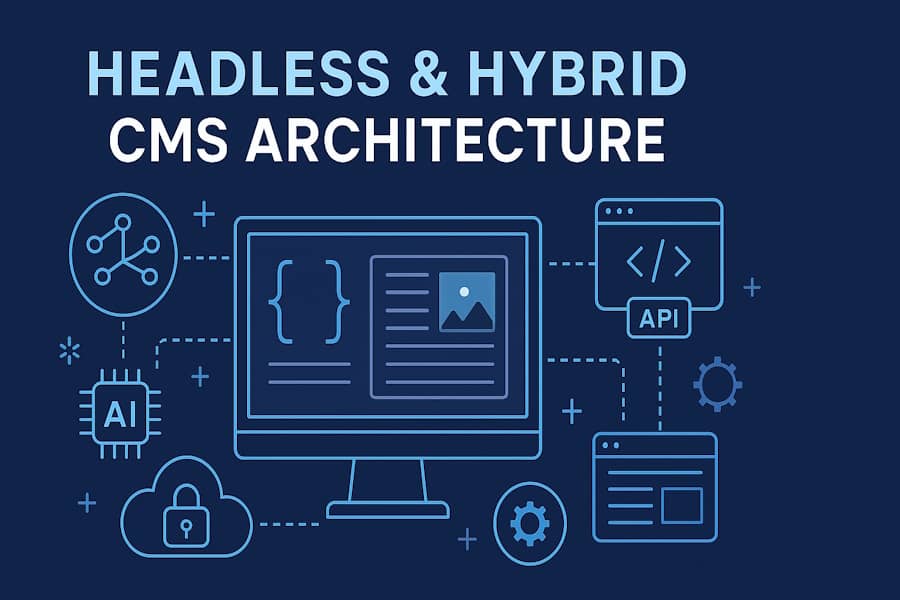The way organizations build, deliver, and scale digital experiences is changing fast. By 2026, traditional content management systems are no longer enough. Users expect instant load times, personalized content, and seamless performance across every channel, from web and mobile to wearables, kiosks, and beyond.
That shift is pushing developers toward more flexible, modular architectures. Headless and hybrid CMS models have moved from niche to mainstream, giving teams the freedom to innovate without being confined to a single tech stack. The future of content management isn’t about choosing one system, it's about designing an ecosystem that can adapt, grow, and perform.
From Monolithic to Modular
For years, CMS platforms were built as all-in-one systems, storing, designing, and delivering content from a single backend. That worked fine when websites were the only destination. But as brands began distributing content across apps, smart devices, and social platforms, those monolithic systems started to show their limits.
A modular architecture changes that. By decoupling content storage from presentation, developers can build flexible front ends that pull structured data from a centralized content source. APIs make it possible to deliver the same article, product listing, or image across multiple touchpoints without duplication or downtime.
This separation of concerns makes the system easier to scale, faster to update, and more resilient. Teams can deploy front-end updates without disrupting the editorial workflow, or rebuild a single service without touching the rest of the stack.
Headless vs. Hybrid: Understanding the Difference
A headless CMS delivers pure content through APIs, leaving the design and display entirely up to developers. It’s ideal for organizations managing content across diverse platforms and frameworks.
A hybrid CMS, meanwhile, combines the flexibility of a headless model with the usability of traditional systems. It supports structured APIs for developers but still provides templates, preview tools, and drag-and-drop editing for non-technical users.
The choice between the two often comes down to workflow. Headless systems give complete control to developers, while hybrid models balance that control with collaboration, empowering content teams to work independently without waiting on code updates.
In practice, many teams now take a blended approach: running headless for scalability but keeping hybrid elements for speed and usability. The result is a content platform that adapts to both technical and creative needs.
Key Technologies Shaping 2026 CMS Architecture
The tools behind modern CMS strategies are evolving as quickly as the platforms themselves. Here are the core technologies driving this change:
- APIs and Microservices: Breaking the CMS into modular components that communicate through APIs allows independent scaling and deployment.
- GraphQL and JSON frameworks: More efficient querying and structured content delivery make it easier to fetch exactly what’s needed, reducing payload and load time.
- AI Integration: Automated tagging, translation, and predictive publishing workflows are now built directly into content pipelines.
- Edge Computing and CDNs: Delivering content closer to the user shortens latency and improves consistency across global audiences.
- Security Automation: Built-in authentication layers, role-based access control, and encrypted API connections have become baseline requirements.
The result is a CMS ecosystem that’s faster, leaner, and more intelligent, designed to support the demands of modern developers and editors alike.
Challenges Developers Face During Migration
Migrating from a traditional CMS to a headless or hybrid setup isn’t as simple as flipping a switch. Common obstacles include:
- Legacy Data Models: Old content structures often don’t align with new schema-based architectures.
- Workflow Disruption: Editorial teams must adjust to new publishing processes that separate content from layout.
- Complex Integrations: APIs can multiply quickly, leading to technical debt if not managed carefully.
- Over-Customization: Building too many bespoke solutions defeats the purpose of flexibility.
To overcome these, start small. Migrate one section or feature first, validate the workflow, then scale. Establish clear ownership for API endpoints, document your schema, and keep the editorial team closely involved throughout development. Collaboration between content and code is key to a successful transition.
Performance and Scalability: The Real Test
In 2026, performance isn’t optional, it’s expected. A CMS can have all the right features and still fail if it can’t deliver content fast and consistently.
Performance optimization begins with architecture. Static site generation, intelligent caching, image compression, and CDN routing are essential to minimizing load times. Monitoring API response times and optimizing database queries help maintain consistent performance even during traffic spikes.
When dealing with complex, enterprise-scale deployments, optimizing for scalability can be especially challenging. This guide on overcoming Adobe AEM CMS performance issues and exploring alternative solutions provides practical insights into diagnosing bottlenecks and improving legacy architectures built on older systems.
The takeaway: performance isn’t something you fix later, it’s something you architect from the start.
Building a Future-Proof CMS Strategy
Whether you’re starting from scratch or re-engineering your existing system, here’s a framework for building a sustainable CMS strategy in 2026:
- Audit your current environment. Identify where performance drops, which integrations fail, and what content silos exist.
- Define your priorities. Is your goal flexibility, speed, collaboration, or cost efficiency?
- Design the architecture. Choose between headless, hybrid, or a composable model that fits your workflow.
- Integrate automation. Use build pipelines, linting tools, and automated testing to prevent regressions.
- Iterate continuously. Treat your CMS as a living product that evolves alongside your organization’s needs.
The best CMS strategies are those that evolve gradually, with clear milestones, agile iteration, and constant communication between development and editorial teams.
The Future: Composable, Contextual, and Intelligent
Looking ahead, the CMS landscape is becoming more autonomous and context-aware. AI will increasingly shape how content is structured, personalized, and published.
Composable ecosystems, where CMS, analytics, marketing, and data tools all connect through shared APIs, will dominate enterprise architecture. Developers will focus less on managing infrastructure and more on orchestrating experiences.
Ultimately, the CMS of 2026 won’t just store and deliver content. It will act as a central intelligence hub, predicting what users want to see and automatically optimizing how that content reaches them.
Conclusion: Flexibility Is the New Standard
The future of content management isn’t defined by templates or technology, it’s defined by adaptability. Headless and hybrid CMS architectures give developers the tools to innovate faster, collaborate better, and scale effortlessly.
As digital ecosystems grow more complex, the most successful teams will be the ones that embrace flexibility, not as a trend, but as a philosophy.
In 2026 and beyond, the systems that thrive won’t be the biggest or the most expensive. They’ll be the ones designed to evolve.








